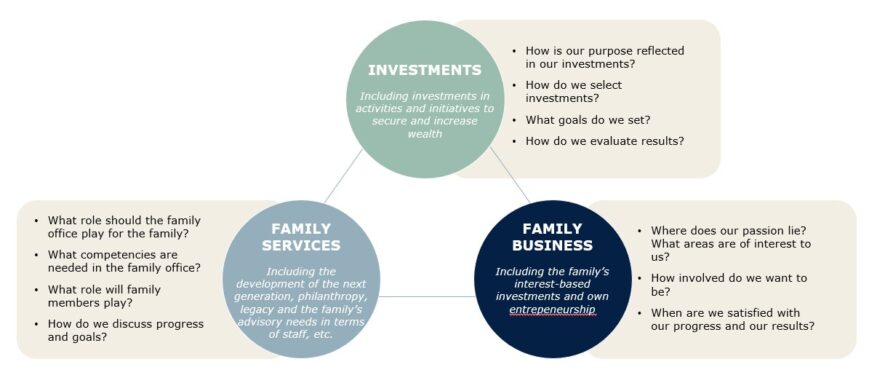Maybe you’ve sold a business. Perhaps your investments have reached a level of complexity where more hands are needed. Perhaps there is a need for the family to have a center that handles the legal, tax and investment needs. Or maybe you just want to be able to focus on other things besides wealth management. Whatever the situation that triggered the need for a family office, it is a milestone for the family and an exciting challenge that require all strategic, branding and HR-related competencies.
Start with the strategy
There is a big difference between an investment company and a family office, and your ownership strategy should help clarify what that difference is. If you approach the task by setting up a family office that looks like an investment company, you risk missing out on the many benefits that a family office can also provide; managing the family’s properties, hobbies and interests, structuring the governance model, developing the next generation as responsible owners, inspiring and running the family’s philanthropy, clarifying roles, education and development for family members – in short, many of the areas that can contribute to peace, harmony, experiences and meaningfulness.
Hence, the ownership strategy should be the first step because it will shed light on the following:
- What the overall purpose of managing the wealth
- What role you, as a family, will play in the ownership
- What interests, history, passion and DNA should form the basis of the investment strategy
- What services the family wants addressed
- What competencies you need to have on board
You are still someone’s boss
Perhaps you have spent many years sitting on boards or at senior management level, and it can be easy to forget that by launching a family office, you are getting close to operations again. This also means that you – again or for the first time – will need to motivate, lead and set the direction of employees. If that is the last thing you want, this should be made clear from the start, so you make sure to hire autonomous individuals in your family office. But even the most self-motivated, self-directed employee may need to know when they are a success, get a Christmas greeting or a pat on the back – in both good times and bad. Furthermore, performance must be evaluated, salaries and benefits negotiated, and a direction set for the year. It is a good idea to decide early on who in your family is responsible for negotiations and ensuring there is a good atmosphere among employees.
Evaluating family office performance can be difficult to do if you have not set clear goals and expectations in advance, which brings us to family office business strategy.
15 questions and answers about the family office’s business strategy
Typically, business strategy can be summarised on the following questions: Who do we want to be, where do we want to play, how do we want to win, how do we get there, how do we follow up? The answers to these questions form a good foundation for the family office’s workflows and objectives. If you want to go a step further, you can develop a clear business strategy for each of these three areas that the family office spans: Investments, family business and family services. Below we have translated the business strategy questions into each area.
Who do we want to be, where do we want to play, how do we want to win, how do we get there, how do we follow up?
Once the direction is set for each of the family office’s work areas, you have a clear overview of which profiles to hire, how many people are needed and how to evaluate them. In other words, the new family office operating model can be implemented quickly, creating the link between strategy and execution.










